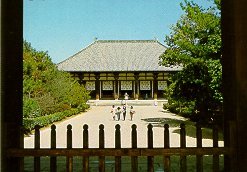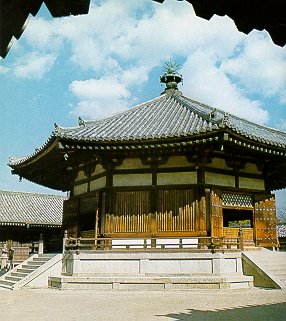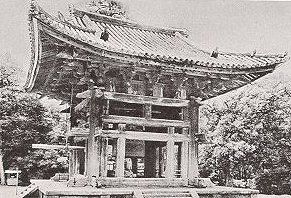
Nara Era: 710-794
The Nara period is usually divided into two parts: the Early Nara period (646-710) and the Nara proper (710-794.)
Missions that had been sent to China during the Asuka period returned with information about Buddhism, Confucianism and other aspects of Chinese culture. These became very popular and the capital of Nara was modeled exactly on the Chinese capital of Ch'ang-an, the capital city being moved to Nara in the year 720.
The Japanese also modeled their government after the Chinese system. Rules were established to govern every aspect of a person's life. People were also classified into different ranks and were required to wear clothing with colors and styles approved for each specific rank. Confucianism, with its emphasis on ancestor worship and obedience to the emperor became very influential. Buddhism, meanwhile, basically absorbed the native Shinto practices.
Prince Shotoku, the imperial regent from 593 through 622 is the one credited with being the main innovator. He was an avid Buddhist and had many temples built.
Two national histories were compiled (Kojiki and Nihon Shoki) and the Man'youshu, which was an anthology of Japanese poems. A high level of culture came into being from the blend of Chinese and Japanese elements.
Few of the buildings built during this time still remain. The temple of Toshodai-ji was founded in 759 by a famous Chinese monk named Ganjin. Parts of the structure have been destroyed, but parts still exist. The kondo and the koda both still exist.

The kondo from toshodai-ji.
At Horyu-ji the oldest octagonal building in Japan stands. It is the Yumedono, or Hall of Dreams. It was the chapel for Shotoku Taishi.

The Hall of Dreams
Particular dates of importance
710: Heijo-kyo (now Nara) is built and becomes first fixed capital of Japan
712: Japan's first history, the Kojiki (Record of Ancient Matters) is written.
715-724: Empress Regnant Gensho
720: Japan's second history, the Nihon Shoki (Chronicles of Japan) is written
724-749: Emperor Shomu. He ordered the establishment of a monastery and a nunnery in each province. In 749 he became the first Japanese emperor to renounce the throne in order to become a Buddhist monk.
741: Provinces ordered to build Buddhist monasteries
749-758: Empress Regnant Koken
751: Wooden "Gigaku" masks in Japan
752: Dedication of the Great Buddha of Todai Temple in Nara. Emperor Shomu came out of retirement in order to dedicate the image. The image of the Buddha is the largest bronze structure in the world.
756: After death of the Emperor all his household effects including furniture, mirrors, paintings and jewels are dedicated to Buddha.
758-764: Emperor Junnin
ca. 760: Publication of the poetry anthology known as the Collection of Myriad Leaves (or Man'yoshu). The work consists of 4,516 poems.
764-770: Empress Regnant Shotoku (Empress Regnant Koken rethroned)
765: Kasuga Shrine is founded in Nara
ca. 770: The court orders the production of 1,000,000 Buddhist charms
770-781: Emperor Konin
781-806: Emperor Kammu
784: Capital is moved to Nagoka.
794: Establishment of capital at Kyoto

Belfry of the Todaiji temple in Nara. The bronze bell was cast in 732 although the rest of the structure is from a later time.
|